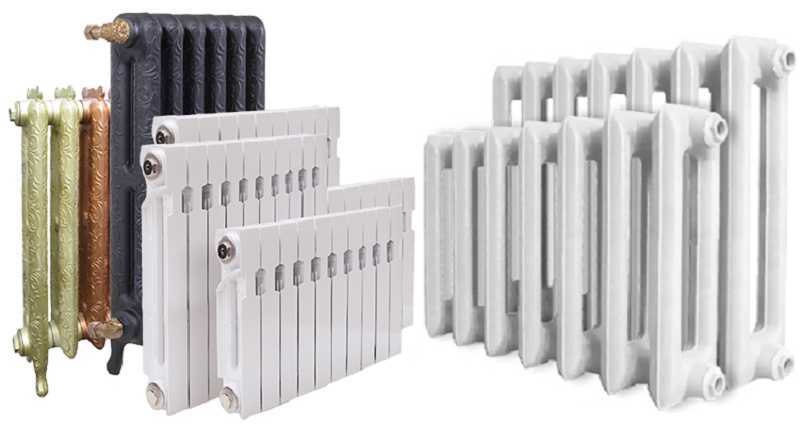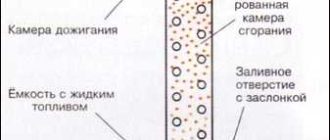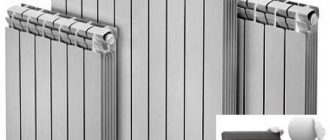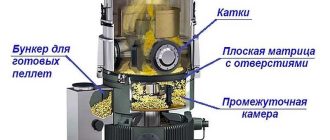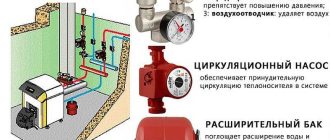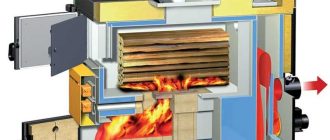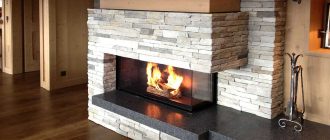Bij het bouwen of renoveren van een verwarmingssysteem worden radiatoren meestal vervangen. Sommige zijn al zo versleten dat ze gewoon niet meer kunnen werken, andere zijn gewoon saai. In elk geval rijst de vraag: "Welke radiatoren zijn beter?". Je wilt tenslotte dat ze mooi en efficiënt zijn. Het uiterlijk van verwarmingsapparaten is zeker belangrijk, maar de keuze van verwarmingsradiatoren moet beginnen met de selectie van de technische kenmerken van uw verwarmingssysteem. Het is immers in de eerste plaats een onderdeel van het technische systeem, en de werkdruk, maximale temperatuur van de koelvloeistof of de samenstelling ervan is veel belangrijker dan vorm en kleur. En na het bepalen van het type geschikte batterijen, kunt u zich bezighouden met de selectie van het model in termen van esthetiek, maar nogmaals, je moet rekening houden met een andere technische parameter - de thermische capaciteit van het gedeelte van de radiator of de hele batterij. Het is dus geen gemakkelijke taak - de keuze van verwarmingsradiatoren.
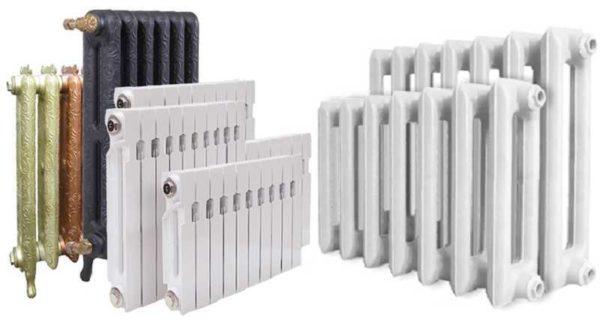
De keuze aan verwarmingsradiatoren is tegenwoordig enorm. Er zijn zes grote groepen, die verschillen in structuur en/of materiaal:
- gietijzer;
- staal (buis en paneel)
- aluminium (gegoten en extrusie);
- bimetaal (volledig en gedeeltelijk bimetaal);
- convectoren (vloer, wand, vloerinbouw);
- plintverwarming.
Radiatoren verschillen qua uiterlijk en eigenschappen, maar het ideale en universele verwarmingstoestel is nog niet uitgevonden. Elke radiatoren heeft voor- en nadelen, en het is alleen in relatie tot elk specifiek geval mogelijk om precies te zeggen welke radiatoren beter zijn. Om een redelijke keuze te kunnen maken, moet je de voor- en nadelen van elke groep kennen.
Inhoud van het artikel
Gietijzeren radiatoren
De oudste verwarmingsapparaten. Ze worden gekenmerkt door een hoge betrouwbaarheid, lange levensduur, verdragen rustig oververhitting van de koelvloeistof (tot +135°C) en reageren normaal op waterslag. Dit alles omdat ze dikke wanden hebben. Maar de grote dikte van het metaal is niet alleen pluspunten, er zijn ook minpunten. De eerste is een grote massa. Niet alle moderne bouwmaterialen zijn bestand tegen het gewicht van gietijzer. Laat ze tegenwoordig lang niet zo zwaar zijn als in de tijd van de USSR, maar nog steeds veel massiever dan alle andere. Een grote massa betekent ook moeilijkheden bij het transport en de installatie. Ten eerste zijn er krachtige haken nodig en ten tweede is het wenselijk om ze met twee personen te monteren - het gewicht van een radiator met 6-7 secties is 60-80 kg. Maar dit is nog niet alles. Een grote metaalmassa heeft een hoge warmtecapaciteit en een aanzienlijke traagheid. Aan de ene kant is dit een nadeel - totdat de batterijen zijn verwarmd, zal de kamer koud zijn, maar aan de andere kant - een pluspunt, omdat ze en afkoelen lang zal duren. Er is nog een nadeel van de hoge inertie - gietijzeren accu's zijn niet effectief in systemen met thermostaten. Dit alles samen en leidt tot het feit dat gietijzeren radiatoren verwarming vandaag de dag is niet zo vaak.
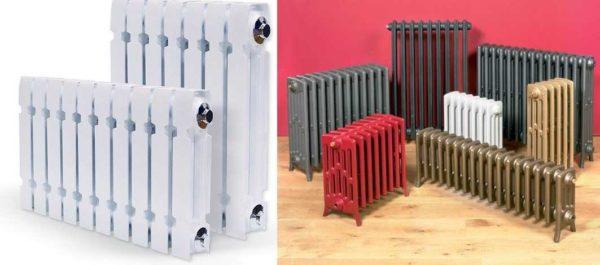
Maar ze hebben hun eigen toepassingsgebied - flatgebouwen. Als de verdieping hoger is dan 16, ontstaat in dergelijke systemen een hoge druk, die alleen bestand is tegen gietijzeren en sommige soorten bimetalen radiatoren (volledig bimetaal). Zelfs hun eigenschappen zijn optimaal in verwarmingssystemen van particuliere huizen en huisjes met conventionele ketels op vaste brandstof zonder automatisering. Deze ketels hebben een cyclisch werkingsprincipe, waarbij het koelmiddel wordt verwarmd tot het kookpunt of zelfs hoger, en vervolgens wordt afgekoeld. Gietijzer reageert normaal op hoge temperaturen en door traagheid worden temperatuurschommelingen afgevlakt.
Tot voor kort hadden gietijzeren radiatoren een onaantrekkelijk uiterlijk - de bekende en al lang verlaten "accordeon". Tegenwoordig zijn er modellen die eruitzien als aluminium of bimetaal - met gladde randen aan de voorkant, geverfd met poederemaille (meestal - wit). Er zijn veel designermodellen, meestal op poten, versierd met gegoten ornamenten. Deze optie is er over het algemeen alleen in gietijzer, alle andere hebben vooral een meer sober, ascetisch ontwerp.
Aluminium
Aluminium verwarmingsradiatoren worden niet gemaakt van zuiver aluminium, maar van een legering op basis daarvan. Dit metaal is niet toevallig gekozen, want het heeft een van de hoogste warmteoverdrachtscoëfficiënten - 4-4,5 keer beter dan gietijzer en 5 keer beter dan staal.
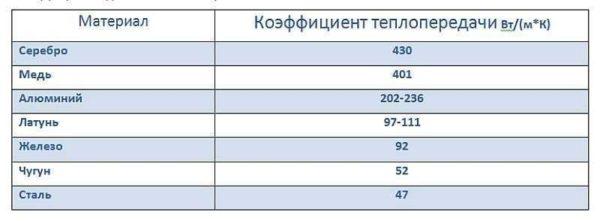
Daarom onderscheiden aluminium radiatoren zich door een hoog vermogen (180-190 W per sectie), een niet minder hoge verwarmingssnelheid en een lage massatraagheid. Ze werken zeer effectief in combinatie met thermoregulatoren, waardoor je een stabiele temperatuur kunt handhaven met een nauwkeurigheid van één graad. Aan de pluspunten van aluminium radiatoren kan hun lage gewicht worden toegeschreven (één sectie weegt 1,5-2 kilogram), wat de levering en installatie vergemakkelijkt. Een ander positief punt - de vorm is zo ontworpen dat het een grote dwarsdoorsnede van kanalen voor de koelvloeistof heeft (iets minder dan de gietijzeren "accordeon"). Dit is goed, omdat de kans klein is dat deze kanalen verstopt raken en de radiator stopt met verwarmen.
Nu over de nadelen van aluminium radiatoren. Deze hebben te maken met de eigenschappen van aluminium. Zoals je weet is het een chemisch actief metaal. Het reageert actief met het grootste deel van de chemische tabel en reageert vooral heftig met koper. En in moderne verwarmingssystemen worden vaak koperen onderdelen aangetroffen. Deze buurt bedreigt de snelle uitvoer van koperen onderdelen van het systeem en uitval, evenals verhoogde gasvorming. Met de gassen geleerd om te vechten - in de systemen van automatische gas ontluchters (kleppen), en koper wordt opgeslagen door het niet in de buurt van aluminium apparaten. Natuurlijk is het proces nog steeds aan de gang, maar niet met een dergelijke intensiteit.
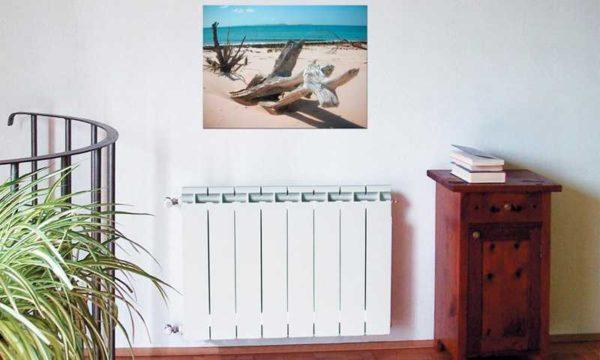
De chemische activiteit van aluminium komt ook tot uiting in de veeleisende kwaliteit van de koelvloeistof. Niet in de zin van verstopping, maar in de zin van de zuurgraad. Normaal werken aluminium radiatoren in systemen waarbij de zuurgraad van de koelvloeistof niet hoger is dan 7 (Ph 7).
Niet erg goed voor de werking van het verwarmingssysteem en zachtheid van aluminium. In de legering waarvan de radiatoren zijn gemaakt, zitten additieven die de hardheid verhogen, maar toch werken ze niet in netwerken met hoge druk. De gebruikelijke werkdruk is 8-16 Atm, afhankelijk van het type en de fabrikant.
Op basis van al het bovenstaande is het gebied afgebakend waarin aluminium radiatoren het beste tot hun recht komen. Dit zijn individuele verwarmingssystemen met ketels geregeld door automatisering. Niet slecht voelen ze zich en in appartementen, maar alleen in gebouwen met kleine verdiepingen (tot 10 verdiepingen), die koelvloeistof met Ph 7-8 circuleert.
Bimetalen radiatoren
Om de tekortkomingen van aluminium radiatoren te verhelpen werden bimetalen radiatoren uitgevonden. Binnen de aluminium mantel werden roestvrijstalen buizen gesloten. Roestvrij staal staat bekend als chemisch neutraal en zeer sterk. Zo worden twee problemen in één keer opgelost. Maar de kosten van bimetalen radiatoren worden veel hoger - de productietechnologie is gecompliceerder en de warmteafgifte is zelfs iets lager. Gemiddeld is de warmteafgifte van één sectie bimetalen radiatoren van standaardafmetingen 170-180 W. Een ander pluspunt is de hogere werkdruk waarmee deze radiatoren kunnen werken. Gemiddeld is dat 20-30 Atm, wat zelfs voor hoogbouw meer dan voldoende is.
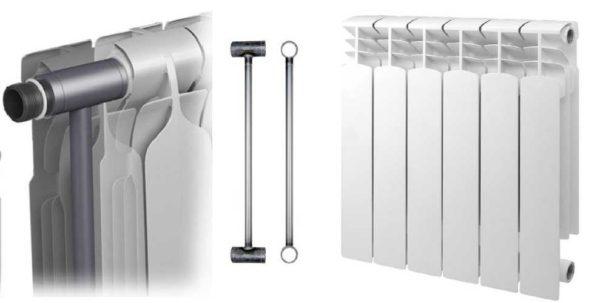
Tegelijkertijd komt er nog een probleem bij: de doorsnede van de kanalen voor de koelvloeistof in bimetalen radiatoren is veel kleiner dan in aluminium. Daarom is het wenselijk om vóór de radiator filters te installeren. Minpunten, zoals je ziet, niet zo veel, maar er zijn nuances. Er zijn eenvoudigweg twee soorten bimetalen radiatoren: volledig en gedeeltelijk bimetaal. Bij het volledig bimetaal zijn alle collectoren (kanalen waar de koelvloeistof doorheen stroomt) gemaakt van roestvrij staal. Als je beslist welke bimetalen radiatoren beter zijn, dan is het de volledig bimetalen. In gedeeltelijk bimetalen radiatoren van roestvrij staal alleen verticale collectoren, en horizontale - van aluminium. Dat wil zeggen, dergelijke producten hebben een iets lagere chemische activiteit, maar nog steeds op een vrij hoog niveau en de werkdruk is veel lager.
Nu verwarmingssystemen, waarvoor bimetalen radiatoren het beste zijn. Dit zijn gebouwen met meerdere verdiepingen en elk type koelmiddel (inclusief zeer zure of alkalische). In individuele verwarmingssystemen zullen hun eigenschappen niet worden opgeëist, dus je moet niet te veel betalen.
Stalen radiatoren - paneelradiatoren en buisradiatoren
Er zijn twee verschillende soorten stalen radiatoren, met verschillende eigenschappen en een heel verschillend uiterlijk. Dit zijn buisradiatoren en paneelradiatoren. De ene is gemaakt van stalen buizen, de andere van stalen platen. Beide hebben een relatief lage prijs, wat ze aantrekkelijk maakt. Maar staal in verwarmingssystemen "leeft" niet erg lang, dus het zijn ook de verwarmingsapparaten met de kortste levensduur. Natuurlijk zijn er uitzonderingen - sommige fabrikanten bedekken buizen of platen met een beschermende laag, zodat de garantieperiode een decennium of zelfs meer bedraagt. Maar de prijs van dergelijke stalen radiatoren is ook niet gering.
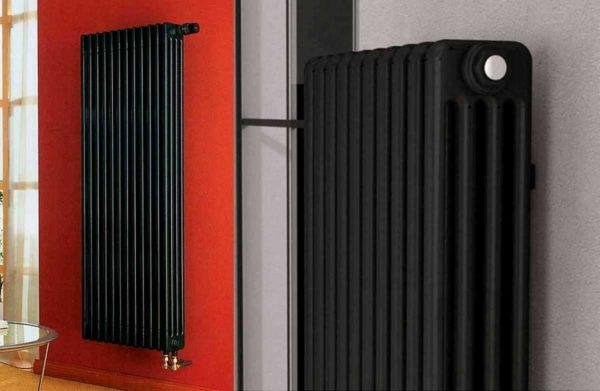
Van de andere kenmerken - een kleine thermische traagheid, veeleisend voor de koelvloeistof. Bovendien, en de zuurgraad, en de aanwezigheid van vreemde deeltjes. Bijzonder veeleisende paneelmodellen - ze zijn gegoten dunne kanalen waardoor de koelvloeistof beweegt. Ze zijn nog dunner dan bimetaal, dus filters bij de ingang zijn strikt verplicht. Als we het hebben over de zuurgraad van de koelvloeistof, dan is de hoogste waarde waarbij stalen radiatoren werken Ph8. De werkdruk is ongeveer 10-16 Atm.
De capaciteit van de verspreiding is zeer groot. Het ontwerp van zowel paneel- als buisradiatoren is zodanig dat ze verschillende afmetingen kunnen hebben. Paneelradiatoren met een hoogte van 30 cm tot 90 cm en een lengte van 40 cm tot 3 m worden in serie geproduceerd. Er zijn speciale modellen die in de hoogte uitgerekt zijn. Hun maximale hoogte is 2,7 meter (op speciale bestelling kunnen ze hoger gemaakt worden, maar dan ontstaan er problemen met het transport).
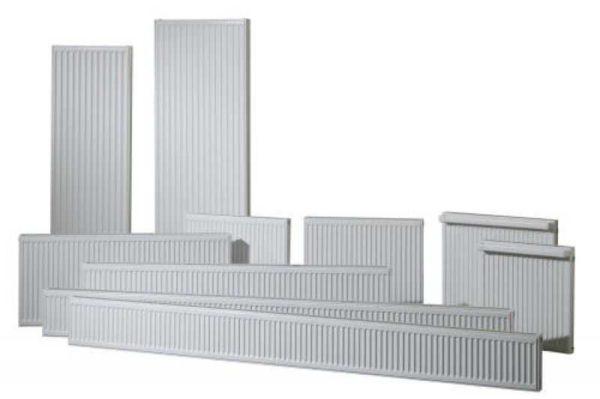
De spreiding in afmetingen van buisradiatoren is nog groter. Ze kunnen een hoogte hebben van 19 cm tot 3 m, een breedte van 10 cm (twee secties) tot 3 meter, een diepte van 6 cm tot 21 cm. Het vermogen van deze radiatoren hangt niet alleen af van het aantal secties, maar ook van het aantal kolommen (buizen in één rij). Er kunnen twee tot zes kolommen zijn. Twee tot drie kolommen kunnen aan de muur worden gehangen, bredere worden vaker op de vloer geplaatst. In tegenstelling tot alle andere radiatoren zijn de secties van buisradiatoren niet afneembaar, dat wil zeggen dat ze niet kunnen worden toegevoegd of verkleind. Ze zijn aan elkaar gelast. Aan de ene kant - minder lekken, maar aan de andere kant - minder mobiliteit. Maar dit wordt gecompenseerd door hun hoge plasticiteit - stalen buisradiatoren kunnen worden gebogen - zelfs rond de kolommen van hun installatie of wikkel grote containers met planten (er is een minimale buigradius). Er zijn trouwens ook modellen in de vorm van banken of tafels.
Convectoren
De laatste tijd wordt beglazing van vloer tot plafond steeds populairder. Echt mooi, maar hier is hoe te zijn met verwarming....question. Het is mogelijk om lage radiatoren op pootjes te zetten, maar de hele chic wordt dan besmeurd. Dan gebruiken ze vloerconvectoren. Onder hen wordt in de vloer een nis gemaakt en het apparaat zelf wordt in de vloer geïnstalleerd en afgesloten met een rooster. Om de warmteafgifte te verhogen (noodzakelijk voor de periode van koud weer), worden er ventilatoren ingebouwd. De oplossing is esthetisch, maar dergelijke systemen kosten veel. Er is nog een nuance - ventilatoren, zelfs de stilste, maken lawaai. Sommige mensen storen zich niet aan dit geluid, terwijl anderen er erg veel last van hebben. In elk geval zijn er meer en minder luidruchtige modellen.
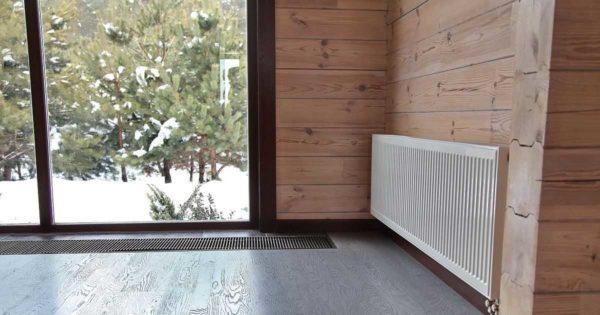
Dus als je een Frans raam van vloer tot plafond moet verwarmen, is een vloerconvector de beste optie.
Basisplaatverwarming
Qua vorm lijkt plintverwarming op plaatradiatoren in oude stijl - het zijn twee buizen met veel dunne plaatjes. Het verschil is dat deze dunne buizen, meestal van koper, zo klein zijn in hoogte en breedte dat ze verborgen zijn achter een hoge plint met een speciale vorm (van boven open). Door de hoge warmteoverdrachtscoëfficiënt van koper is het vermogen van deze kleine radiatoren hoog, het wordt gewonnen door de lengte - zelfs langs de hele omtrek van de kamer.
Naast onzichtbaarheid is er nog een voordeel van plintverwarming: de meeste warmte wordt niet overgedragen door convectie, maar in het infraroodbereik - van de verwarmde muren. Een stroom warme lucht stijgt op langs de muren en verwarmt ze. Als de muren opwarmen, beginnen ze warmte uit te stralen, wat ons lichaam als comfortabeler ervaart. Nadelen van dit systeem
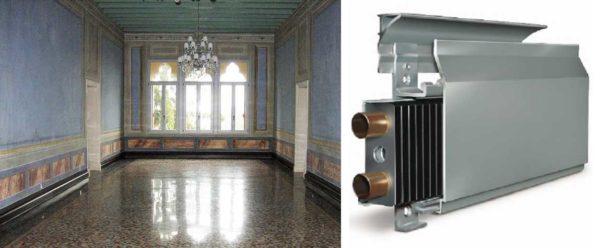
De nadelen van plintverwarming - veeleisend voor de warmtedrager en het thermische regime (het is onmogelijk om oververhit te raken), lage werkdruk (tot 10 Atm). Dit alles suggereert dat dergelijke systemen alleen kunnen werken bij individuele verwarming en met ketels die door automatisering worden geregeld.
Welke radiatoren zijn beter voor appartementen en huizen?
Nu een beetje systematiseren alle informatie vanuit een ander oogpunt - wat is beter om batterijen te kiezen in een appartement, en wat voor een prive-woning of huisje. Laten we het eerst hebben over wat je in appartementen kunt plaatsen. Om alles goed te kiezen, moet je eerst naar het huisvestings- en onderhoudskantoor gaan of met loodgieters praten. Je moet weten welke druk er in je verwarmingssysteem zit en wat de zuurgraad van de koelvloeistof is en de bedrijfstemperatuur (althans volgens de documenten). Het zou fijn zijn om te weten welke temperatuur- en drukpieken optreden. Gewapend met deze cijfers moet je een specifiek model kiezen van die types radiatoren die geschikt zijn voor jouw situatie.
Nu over welke radiatoren beter zijn voor het appartement. Dit zijn de opties:
We vestigen er nogmaals de aandacht op dat je bij het kiezen van een bepaald model zeker moet kijken naar de technische parameters. Alleen in dit geval zullen radiatoren lang werken zonder reparatie en vervanging.
Nu over welke radiatoren beter zijn voor een privéwoning en een vakantiehuisje. Deze systemen hebben een klein volume, verschillen erin dat je bij hen de toestand van de koelvloeistof zelf bepaalt, je kunt de zuurgraad aanpassen, de filters reinigen. De keuze van de zuurgraad is in deze situatie dus niet relevant. Waar je wel rekening mee moet houden is het type ketel. Als het systeem een ketel op vaste brandstof is en er geen warmteaccumulator in zit die temperatuurschommelingen afvlakt, kun je het beste kiezen voor gietijzeren batterijen. Deze zijn bestand tegen oververhitting en egaliseren temperatuurschommelingen met hun thermische traagheid.
In alle andere gevallen zijn aluminium radiatoren de beste keuze. Ze hebben een lage massatraagheid en reageren snel op temperatuurveranderingen. Ze warmen letterlijk binnen enkele minuten op en er is een voelbare warmtestroom. Ze koelen echter ook snel af, zodat in geval van een noodstop het huis snel koud is.
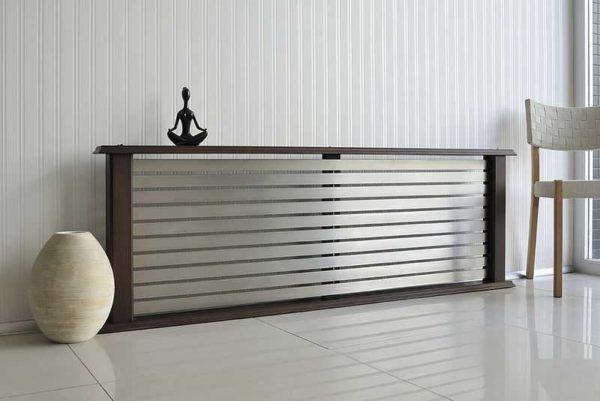
Niet slecht zijn stalen radiatoren. Dit is een voordelige optie, maar ze gaan zelfs bij normale werking niet lang mee - een kleine levensduur. Voor estheten is een variant met plint- of convectorverwarming (ingebed in de vloer) geschikt. Beide systemen werken perfect met elke geautomatiseerde ketel.

